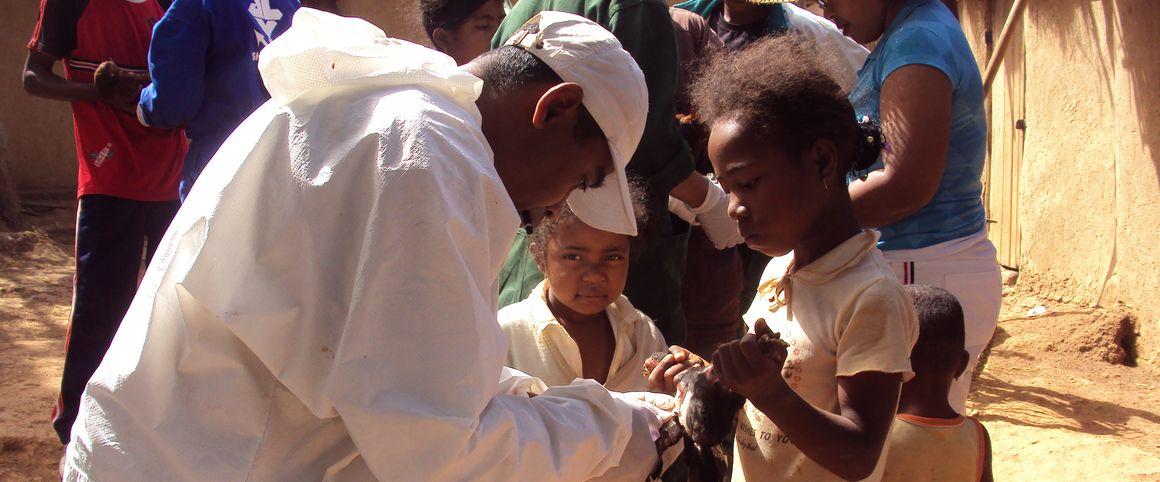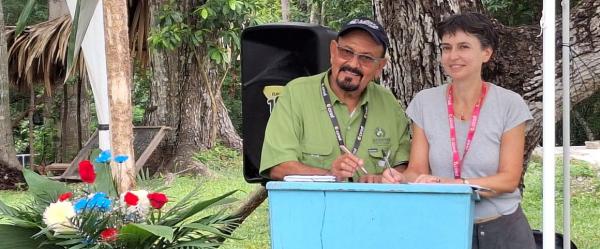Science at work 16 December 2025
- Home
- Press area
- Press releases
- Fight against antimicrobial resistance
CIRAD on the front line of the fight against antimicrobial resistance

Poultry sampling in Madagascar to collect data to assess bacterial resistance to antibiotics © E. Cardinale, CIRAD
Antibiotics, the wonder drugs of the 20th century, are in danger. Their overuse and misuse have amplified antimicrobial resistance. According to the report by O’Neill (2016), this phenomenon, which consists in bacteria becoming resistant to antibiotics, could be responsible for more than 10 million deaths per year and thus become the leading cause of mortality in 2050.
To permanently change the way antibiotics are used in human medicine, veterinary medicine and agriculture, CIRAD and its partners are mobilising different disciplines, following a common approach known as “One Health”. Today, the organization is coordinating two far-reaching international projects, financed by the French government, in the context of the priority research programme on antimicrobial resistance led by the French Alliance for Life Science and Health (AVIESAN).
Preventing transmission
The CIRCUS project (Circulation of multi-drug resistant Enterobacteriaceae in humans, animals and the environment in rural, peri-urban and urban areas in low-and middle-income countries: a One Health approach) looks at epidemiology and microbiology in different contexts (urban, peri-urban and rural) and countries (Burkina Faso, Cambodia, Côte d’Ivoire, Madagascar), in order to analyse the potential circulation of multi-resistant bacteria. “Starting from cases of people carrying or infected by this type of bacteria, we identify cross contamination with members of their family, pets (dogs and cats) or farm animals (poultry, pigs, ruminants), and their environment (drinking water, rodent droppings close to the home)” says Éric Cardinale, a veterinarian at CIRAD and Assistant Director of the ASTRE research unit. “We then analyse the bacterial strains in order to determine how each reservoir participates in the transmission of resistance in humans. Identifying the circulation makes it possible to limit it”, he adds.
At the same sites, the RAMSES project (Resistance to antimicrobials, socio-economic factors and regulations influencing emergence and dissemination in the global South) explores the circulation of antibiotics in pharmaceutical markets, their regulation by human and animal health professionals, and their use by consumers. It also assesses the institutional capacities of the countries in terms of microbiology laboratories and surveillance networks.
“These two projects will give us a substantial factual basis to assist the authorities, in particular the national committees on antimicrobial resistance, in rationalising the use of antibiotics”, says Éric Cardinale.
Antibiotics: fewer and better
Using fewer antibiotics and using them wisely helps to maintain their effectiveness. This is a particularly critical objective for those in the last line of defence, in other words carbapenems, third and fourth generation cephalosporins, and fluoroquinolones. The alternatives? CIRAD is actively participating in their promotion, in particular through vaccination and by stepping up the level of biosecurity in livestock farms and their surroundings.
Rapid, actionable results
When the pressure on them is reduced, bacteria gradually return to a so-called “wild” phenotype that is sensitive to antibiotics. “In Réunion, where CIRAD has conducted numerous projects in this field, the number of farms contaminated by multi-resistant bacteria has declined by 50% in five years”, says Éric Cardinale. He concludes: “Since the countries with which we collaborate belong to regional organisations, if new antibiotic management policies are shared, we can massively increase the reach of our work”.
The other projects underway concern Togo (project to improve control of antimicrobial resistance in hospital environments in Togo), Canada, the Netherlands, Hungary, Senegal, the Philippines (DESIGN project), Vietnam (I-CRET project) and Mozambique (projet ROAD-Map).
The publication AMR Antibiotiques et bactéries – Une histoire de résistance explores the complex phenomenon of bacterial resistance to antibiotics and its consequences, with a view to bringing about changes in practices. This non-specialist document will soon be the subject of a MOOC that will be particularly aimed at CIRAD’s partners in the global South. Antimicrobial resistance analysed holistically, from a “One Health” approach, is also expected to be the subject of a training module.



























